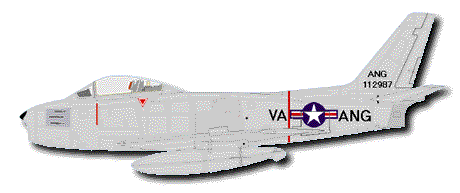
As confusing as this period was
for the Virginia Air National Guard, the new aircraft assigned
to the unit were almost as confused.
The aircraft destined to serve, albeit shortly, with the Virginia
Air National Guard were designated F-86E-15-NA. Despite the designation,
the aircraft were originally ordered as a group of 100 more advanced
F-86F-15-NA.
However, in April 1952, delays in deliveries of General Electric
J47-GE-27 engines forced earlier, lower powered -13 engines to
be substituted in their stead in all but the first seven aircraft.
The 93 redesignated E-15's were issued to the Air National Guard
and training units rather than front line units.
Thus, despite its "E" designation, the Virginia Sabre
Jets had much more in common with "F" models.

F-86E day fighter
The first major production version
of the day-fighter Sabre was the F-86E. It was identical to the
initial F-86A version except for the presence of an "all-flying"
tailplane.
The first F-86E (50-579) made its maiden flight on September 23,
1950. Instead of the traditional mechanically adjustable stabilizer
for trim control, the F-86E's elevators and horizontal stabilizer
operated as one unit.
The horizontal stabilizer was
pivoted at its rear spar so that the leading edge was moved eight
degrees up or down by the normal action of the controls. The elevator
was mechanically linked to the stabilizer and moved in a specific
relation to the stabilizer movement, with elevator travel being
slightly greater than stabilizer travel.
The all-flying tail of the F-86E eliminated many undesireable
compressibility effects which had been experienced with the F-86A.
In other respects, the F-86E was similar to the F-86A.
There were supposed to be only two models of the "E,"
the E-1 and E-5. (120 Canadian-built F-86E-6-CAN were also produced.)
However, the follow-on F-86F was delayed by shortages of the 5,910-lb.
static thrust J47-GE-27. Thus, the first 132 "F's" off
the production line were completed as F-86E-10-NA's.
The 132 E-10's had provisions for the installation of the -27
engine once it became available. Externally, the E-10's could
be easily distinguished from all earlier F-86 version, including
its E-model siblings by an optically-flat windscreen which replaced
the V-shaped windscreen of the earlier models. Internally, it
also received a modified instrument panel.
Further delays in deliveries of -27 engines caused the last 93
aircraft on the F-86F contract, scheduled to be produced as F-86F-15-NA,
to be completed as F-86E-15-NA's. These being quite similar to
the F-86F-10-NA version. The E-15's,
the lot from which the Virginia Air National Guard received its
Sabre Jets, were manufactured from August to December of 1952.
These aircraft were used only by training and ANG units.
A total of 456 F-86Es were built in the following blocks:
60 F-86E-1-NA
51 F-86E-5-NA
120 F-86-E-6-CAN
132 F-86E-10-NA
93 F-86E-15-NA
Serials of the F-86E-15-NA
51-12977 through 51-13069




